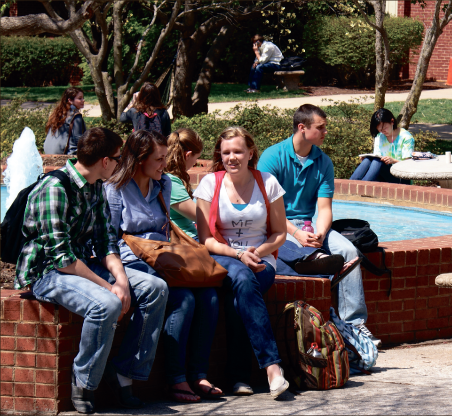Liberty ranks 8th in enrollment

Spring Fever — As the weather begins to get warmer students are beginning to relax and study outdoors. Photo Credit: Ruth Bibby
Liberty University now ranks eighth in the nation as the largest, four-year university according to new numbers from the U.S. Department of Education. With a total enrollment of 64,610 students, Liberty is also the largest university in Virginia.
Enrollment has increased by 40 percent since 2009, according to data from last year that reported a total enrollment of 46,312.
”We are proud that Liberty has become the national leader among nonprofit universities in online education,” Chancellor Jerry Falwell Jr. said. “These students average 35 years of age and many have lost jobs and are in need of learning new skills to succeed in the new economy that has emerged. They cannot relocate their families to attend college so Liberty is providing these families a second chance, and we are the only major online university to provide this re-training in the context of a Christian worldview.”
University figures from fiscal year 2010 report residential enrollment of over 12,000 while online enrollment was over 52,000.
According to a study by the Mangum Economic Consulting, LLC of Richmond, Va., based on data from 2009, between 1992 and 2009, the university’s fall enrollment increased from 8,500 to 46,949, an increase of 452 percent. Over that same period, Virginia’s other four-year private non-profit colleges and universities grew by 32 percent, and Virginia’s four-year public colleges and universities grew by 29 percent.
“Liberty is growing because Liberty is unique. We offer an alternative to the religion of secularism and the political correctness that is so pervasive at most universities,” Falwell said. “We have also worked hard to keep education at Liberty affordable.
Consulting, LLC of Richmond, Va., based on data from 2009, between 1992 and 2009, the university’s fall enrollment increased from 8,500 to 46,949, an increase of 452 percent. Over that same period, Virginia’s other four-year private non-profit colleges and universities grew by 32 percent, and Virginia’s four-year public colleges and universities grew by 29 percent.
“Liberty is growing because Liberty is unique. We offer an alternative to the religion of secularism and the political correctness that is so pervasive at most universities,” Falwell said. “We have also worked hard to keep education at Liberty affordable. We are often criticized for managing our expenses so closely but, in all the surveys, our students and prospective students say that Liberty’s affordability was the second most important reason they chose Liberty. Only our Christian mission was more important to our students.”
Along with the university’s substantial growth and elevated rank, Liberty’s students also received $445 million in federal aid for the 2010-11 award year, according to new data from the U.S. Department of Education.
This figure ranks Liberty as the top recipient among Virginia schools. However, because Liberty places such a high priority on fiscal management, each student at Liberty needed and received less federal grant aid on average to pay for their education than their peers at other colleges, according to Falwell.
Enrollment and the FAFSA are the primary drivers in addition to the legislation in place that effects all Title IX aid recipient institutions, according to Director of Research and Analysis Richard Martin.
“LUO is a significant part of Liberty University,” Martin said.
Martin explained that despite the big numbers, what cannot be lost is that it takes a substantial operation to ensure that financial aid is managed for such a large and diverse student body.
“No matter how large the student body is, financial aid is worked at the individual student level, regardless of whether that student is being serviced at the Student Service Center at Campus North or over the phone from Aurora Colo., whether the student is a 21-year-old married aviation major or a 48-year-old single Juris Doctorate candidate, or whether the student primarily speaks another language,” Martin said. “All and more than the factors above are differences that can matter and can be combined in any way at any time and must be managed in accordance to laws that are constantly being revised in a ‘service-now’ environment.”
